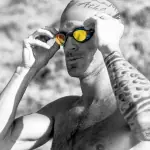
The core is the foundation of the body, and without it, we'd be unable to stand upright, much less swim, bike or run. But, are you truly using your core? Is it something you consciously think about and engage during each of your three sports?
Role of Core in Freestyle
To keep things simple, it's important to understand your core is used during all phases of freestyle. An engaged core helps connect the precise movements of the body during the stroke cycle--from fingers to toes. Freestyle body posture should resemble that of ideal standing posture. Thanks to core stability, achieving a neutral spine is possible.
Triathlon Events Near You
More: The Case of the Unhealthy Triathlete
Whenever a swimmer moves, the core tenses first. In a predominantly overhead sport such as swimming, the core is asked for constant engagement to link the movement and load of the arms with the kick and rotation of the body. If the core is disengaged, the swimmer will have a disconnect between the shoulder and hip drive, losing a great transfer of power.
Key Focuses
First, confirm that your breathing pattern is efficiently in place. The diaphragm (the main muscle for breathing) is part of your core and directly influences the effectiveness of other core muscles during swimming. The goal is to breathe every two strokes with a smooth, seamless inhale/exhale pattern without holding the breath at any point.
Next, let's address the amount of load, or tension, that should be held in the core during the entire stroke cycle. Imagine doing a plank on the ground--the goal is to replicate the same engagement and tautness necessary to maintain a long, stacked position. Without the backside of your core firing off during freestyle, your legs will drop low in the water and be misaligned with your upper body. Play around with how tight you keep your core, as too much load will feel restricted and stiff, and too little will feel lose and sloppy.
Keep your core connected! Be mindful of the symmetry of your core/body, and know how to recognize when you've disconnected from a neutral spine. A common misstep is over-reaching the arm at the front of the stroke, causing a loose, bowed side-body. This lateral movement in the torso causes less power to be transferred from the catch to the propulsive phases of the pull. This inefficiency adds up quickly--for a swimmer who averages 70 strokes per minute on their 1 hour 30 minute IRONMAN swim, they're compromising their power on 6,300 strokes. To correct this over-reach and core disconnection, maintain active retraction of your shoulder blades throughout all phases of the stroke.
Practice Makes Perfect
Side-kicking is my favorite in-water drill to master the appropriate amount of core recruitment. Perform the drill one side at a time, followed by a length of freestyle after each.
With fins on, kick while rotated between 45 to 60 degrees on your side, with your lower arm extended straight in front of your head, while the top arm is laying flat along your side and hip. This body positioning accurately represents how you are currently posturing during full freestyle. If you notice that your lead arm is out-stretched and/or crossing in front of your head, you'll also notice the bowing in your side body we discussed earlier. This drill allows you to look closely at each separate element of the stroke, in order to integrate these changes into your freestyle.
More: Why Triathletes Should Cross Train
There are plenty of exercises out of the water to build core stability and muscular awareness, but my favorites are plank and side-plank. These improve core strength but also recruit nearly every muscle in your body if done properly. The beauty of this exercise is that its prone position and posture is nearly identical to streamline position in the water during freestyle.
Freestyle is incredibly dynamic, and it's clear that the core is the integral piece that connects each and every movement of your freestyle stroke. The more educated you are on how your body moves and works with the water, the smoother and faster you'll be able to cruise through it.



